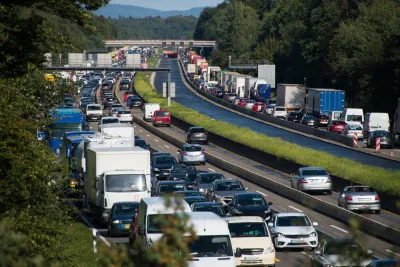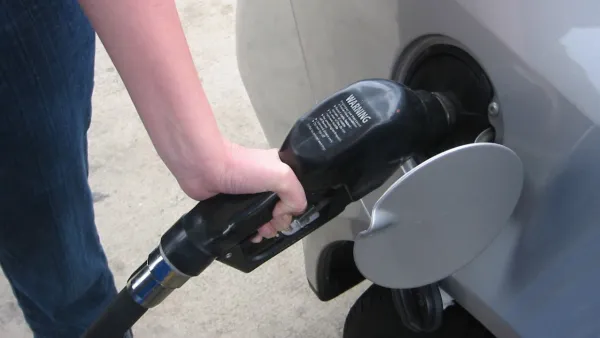The inventory, a requirement from a 1992 U.N. treaty, shows emissions from most sectors are either decreasing or holding steady. The major exception: transportation.

The U.S. Environmental Protection Agency met its requirement under the U.N. Framework Convention on Climate Change, signed by President George H. W. Bush on October 13, 1992*, by releasing the draft on Feb. 7.
"The agency's inventory shows that the United States, the world's richest nation, released 15 percent of global carbon dioxide emissions in 2015," reports Jean Chemnick, who covers international climate policy for Climatewire.
It also shows that U.S. emissions in 2016 were 11.6 percent lower than in 2005, a downward trajectory supported by the power sector's shift from coal to natural gas. Warmer winters also contributed to that drop.
[See EPA webpage for introduction and access to "Inventory of U.S. Greenhouse Gas Emissions and Sinks" or go directly to the 649-page draft inventory [pdf]. Two figures from the report are referenced below and identified by page number.]
Emissions from the transportation sector, on the other hand, have been increasing since 2013, though still below their 2008 peak, as Figure ES-14: U.S. Greenhouse Gas Emissions Allocated to Economic Sectors [million metric tons of carbon dioxide equivalents (MMT CO2)] on pg. 49/649 [or pg. ES (Executive Summary) - 24. Also accessible by clicking on the respective link in the Table of Contents: List of Tables, Figures, and Boxes, beginning on page IX.
While the graph, which ends in 2016, shows emissions from the electric power industry and transportation essentially tied at total emissions, transportation took the unenviable #1 position that year when measuring just carbon emissions, according to a June post in Planetizen:
"For the first time since 1979, America’s cars, trucks, and airplanes emit more carbon dioxide than its power plants do," according to an article by Brad Plumer.
The increase in transportation emissions, resulting from an increase in petroleum consumption, correlates with an increase in vehicle miles traveled and a leveling in the fuel economy of new vehicles sold, stalled at roughly 25 mpg since 2014, according to monthly monitoring records by the Sustainable World Foundation, University of Michigan Transportation Research Institute.
Petroleum was far away the #1 contributor to carbon dioxide emissions in 2016, accounting for 44.1 percent, with natural gas and coal contributing 29.7 percent and 26.3 percent, respectively, according to Figure ES-6: 2016 CO2 Emissions from Fossil Fuel Combustion by Sector and Fuel Type [pg. 36/649, or Executive Summary ES-11.]
"The third-largest contributor of emissions in 2016 was forests, due to an unusually active wildfire season," adds Chemnick.
- See EPA instructions for submission of comments by March 9.
- *Three years before signing the U.N. Framework Convention on Climate Change, President George H.W. Bush established the U.S. Global Change Research Program that requires Federal agencies and departments to prepare an annual National Climate Assessment.
- E&E News is subscription-only. I wasn't able to locate any other articles on the release of this important inventory.
Hat tips to Darrell Clark and Ned Ford.
FULL STORY: UNITED NATIONS: U.S. releases CO2 inventory required by climate treaty

Analysis: Cybertruck Fatality Rate Far Exceeds That of Ford Pinto
The Tesla Cybertruck was recalled seven times last year.

National Parks Layoffs Will Cause Communities to Lose Billions
Thousands of essential park workers were laid off this week, just before the busy spring break season.

Retro-silient?: America’s First “Eco-burb,” The Woodlands Turns 50
A master-planned community north of Houston offers lessons on green infrastructure and resilient design, but falls short of its founder’s lofty affordability and walkability goals.

Test News Post 1
This is a summary

Analysis: Cybertruck Fatality Rate Far Exceeds That of Ford Pinto
The Tesla Cybertruck was recalled seven times last year.

Test News Headline 46
Test for the image on the front page.
Urban Design for Planners 1: Software Tools
This six-course series explores essential urban design concepts using open source software and equips planners with the tools they need to participate fully in the urban design process.
Planning for Universal Design
Learn the tools for implementing Universal Design in planning regulations.
EMC Planning Group, Inc.
Planetizen
Planetizen
Mpact (formerly Rail~Volution)
Great Falls Development Authority, Inc.
HUDs Office of Policy Development and Research
NYU Wagner Graduate School of Public Service



























